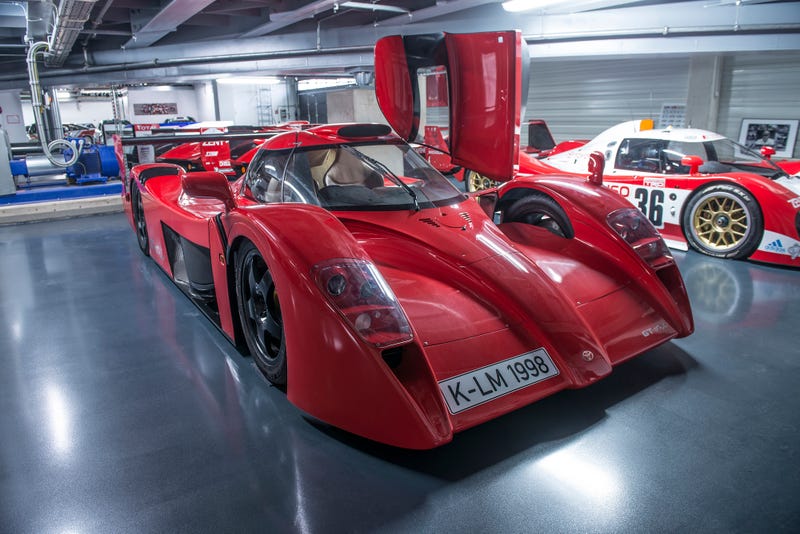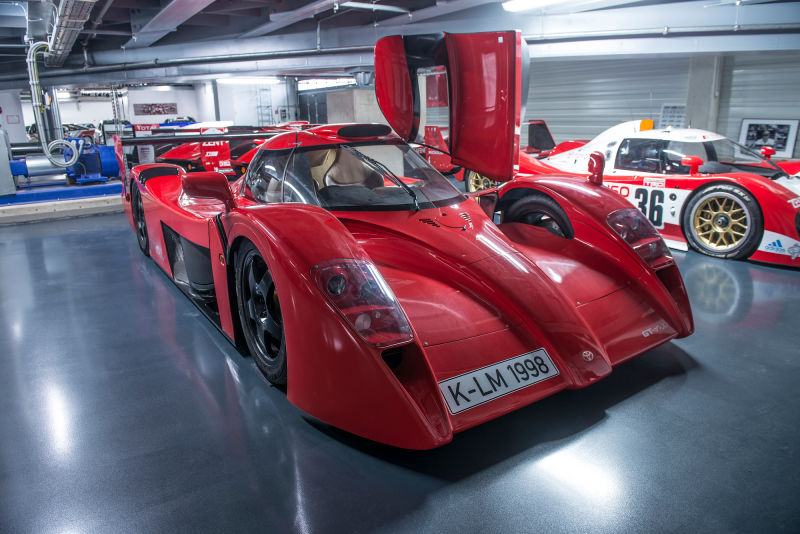
The 1990s GT1 category was dominated by greats. The Toyota TS020. The Mercedes CLK GTR. The Porsche 911 GT1. But the best cars were actually not these racers. They were the road cars borne out of them.
It’s a little unclear, to be perfectly honest, why some of these cars exist. Everyone seems to be in agreement that the rules of GT1 and its immediate predecessor, the BPR Global GT Series, had some sort of homologation requirement in place for their purpose-built race cars. But what gets fuzzy –especially for the manufacturers involved – was not only how many road cars were supposed to be built, but if any were required to be built at all. And under what specification? The Toyota GT-One road car, for instance, was barely a road car at all, and as far as we can tell Toyota only made two. At least 20 Mercedes CLK GTR road cars were built, on the other hand, but in varying specifications.
Advertisement
Advertisement
Some had one engine, some had another. Some had a roof, and some, well, didn’t.
It’s hard to express what makes these road cars “great” in my mind. Unlike the road cars that became great racers, like the McLaren F1, there’s something a bit bad about them. Maybe it’s their brutal speed. Maybe it’s their artful elegance. Most probably it’s the fact that most of these were barely road cars at all, and were more homologation specials. It’s wildly inappropriate for them to be even near a public road, and yet, here they are. That makes them special.
But it didn’t hurt that they were gorgeous.
Sponsored
And there was no racer-derived road car prettier than the Mercedes CLK GTR.
The Mercedes CLK GTR
All the real “need-to-know” information about the Mercedes CLK GTR can be gleaned from that one photo right there. That, right there, is the epitome of the classic race car shape to an entire generation. It’s long and low, with every proportion seemingly exaggerated. The front doesn’t contain an engine, yet it’s far forward of where the driver is sitting. The rear is even further behind, capped off by louvres where the engine sits and a wing hanging out into space. The middle is a sleek pod reminiscent of an egg with a hood scoop on top. The mirrors sit on the fenders, where they belong. There are swoops and scoops everywhere. The wheels unintentionally harken back to the ones on the DeLorean DMC-12. The doors are mere cutouts that swing diagonally upwards.
But if you surely must hear more about the CLK GTR road car, I’m only too happy to oblige. Despite the “CLK” in the name, only the instruments, grille, and headlights came from the Mercedes-Benz CLK coupe. Virtually everything else about it was a prototype race car. The only storage compartments existed as little lockers below the doors. The engine, in the standard version, was a 6.9-liter V12 with more than 600 horsepower. It cost more than $1.5 million when new.
And then there were the variants. After the initial batch of 20 were built, there were a smattering of roofless roadsters and steroidal Super Sports, featuring the 7.3-liter V12 out of the Mercedes-Benz SL73 AMG (and later, the Pagani Zonda). That helped for another 50 or so horsepower.
Every so often these rare beasts come up for sale. Just last year one was on offer at the Goodwood Festival of Speed. A little while before that, one actually had trouble finding a new owner despite the low, low price of $1.4 million.
Hell, for that price I’d let you keep the engine cover.
The Porsche 911 GT1
This German beast was the one that actually started the GT1 craze for me. Despite its name, however, the Porsche 911 GT1 wasn’t a Porsche 911 at all, not really. It was a weird mashup of the 911 and the all-dominating Porsche 962. It had a mid-mounted, twin-turbo, water-cooled flat-six, when the standard 911 was still an air-cooled naturally-aspirated mill. The interior appears to have some gauges from the 911, but that’s about it.
Advertisement
Porsche only made approximately 25 of the Porsche 911 GT1 Straßenversion, but they’re almost certainly one of the most interesting cars to bear the “911″ moniker. They’re so rare, in fact, that this one appears to be one of the race cars converted into a road car by the same people who make the McLaren F1 GTR converted road cars:
Holy hell, though, can this thing move. It pops and snarls and buzzes and growls, exactly like a car with an engine should.
The Porsche 911 GT1 used every last bit of its 544 horsepower to muscle down the street, and there were two versions built. The first batch of two had 993-style headlights, whereas the rest had 996-style headlights.
Advertisement
Both are stunning.
The Nissan R390
When Nissan saw everyone else building race cars paired with incredibly tiny numbers of road-going variants, they wanted to get in on the game, too. So they created this oddball, the Nissan R390. The R390 is generally one of the most unloved supercars, owing in part to its lack of racing success, and in part to its relatively dowdy front end. Look at those headlights. It just looks sad.
But that doesn’t mean it wasn’t great in its own right. It was still capable of moving to 60 miles per hour in less than four seconds, and the two occupants are clearly intended to sit in the very center of an enormous and flat rectangle. I’d still give a limb just to own it.
Advertisement
But you can’t. As Eiichi Shimizu, the director of Nissan’s own DNA Garage in Zama, Japan notes, Nissan only built one road-going R390. And it kept it for itself:
The Toyota GT-One
This is the mac daddy. The big one. The Toyota GT-One. The baddest of them all. Mostly because Toyota made such a beautiful mockery of the rules when creating this car, which was known internally as the TS020. I’m a bit unsure as to what rubric Toyota used to define this one as a “road car,” according to the rules, besides slap a license sticker on the front and some leather bits inside.
There are still cutouts on the insides of the fenders, allowing the driver to see the interior bits of the front wheels, and allowing high pressure to escape from what’s left of the wheel wells. It appears to be just a few nanometers off the ground. The trunk on the “road going” version is almost certainly the same as the one on the race car.
Advertisement
That is, the “trunk” is simply the fuel tank. Seriously. Toyota got past race scrutineering by pretending a suitcase could fit inside the fuel tank, if you really wished hard enough.
Only two of these were built, and both appear to have been kept by Toyota. Which is a great shame. The Toyota GT-One is probably one of, if not the closest ways to get a true F1-style race car for the street with nothing but the thinnest of skins atop it.
Advertisement
Wikipedia, funnily enough, seems to give just a bunch of made-up specifications for this road car, which it says features over 1,000 horsepower from its twin-turbo V8 and a top speed of over 260 miles per hour. That’s almost certainly incorrect, but this is entirely a dream car. A unicorn. It might as well not exist. So make up whatever numbers you want. I’ll love it all the same.
The Panoz Esperante GTR1
In contrast to the Toyota GT-One road car, the Panoz Esperante GTR-1 is very much a Real Thing. It’s so real, in fact, that Panoz will probably build you a brand new one right now, if you give them the money to do it. It’ll come with a massive front-mounted (front-mounted!) V8 to rocket your eyeballs back into next Wednesday, and you’ll get color-changing paint, too. Not to mention that it sounds like it’s a Sumerian deity come back from the dead just to screw up everyone’s day:
Oh, and it’s the only American one of the bunch.
All of these are so great. Bring back homologation specials. Bring back GT1.
















